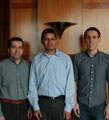
The Department of Computer Science and Engineering is starting 2013 with three faculty members earning one of the nation's most prestigious scientific awards-the Faculty Early Career Development (CAREER) award. Given each year to the nation's top scholars, the CAREER award supports junior faculty who exemplify the role of teacher-scholars. Among the criteria used for the National Science Foundation award: outstanding research, excellent education, and the integration of education and research within the context of the mission of each organization. In conjunction with the award, these assistant professors will receive at least $400,000 to support their research - an investment that according to the NSF will help these young scholars build a foundation for "a lifetime of leadership in integrating education and research." Below are their stories.
Mike Bond joined Ohio State in 2011 with the goal of making modern computer systems reliable and efficient. Achieving this goal presents serious challenges as chip manufacturers make processors faster by adding more and more cores; this trend makes it notoriously difficult for programmers to develop and debug software that is both accurate and fast.
As part of his current project, "Practical Language and System Support for Reliable Concurrent Software," Professor Bond will work closely with graduate and undergraduate students in his research group, Programming Languages and Software Systems (PLaSS), to design and implement the first practical approaches for guaranteeing reliable parallel execution without sacrificing performance. These innovations will ultimately help parallel software systems overcome existing challenges and address society's growing computing needs.
Kannan Srinivasan studies and develops wireless network and communication systems with the aim of improving performance, reliability, and security. He joined the university in 2011 and during that time has investigated everything from networking protocols to measurements to wireless nodes.
His current project, "Together We Rise: A Unified MIMO - Full Duplex Network Architecture," aims to find a solution for one of the field's most pressing problems: the need for higher capacity wireless networks. In the past, wireless networks have relied on a system that uses either all of its antennas for transmission or for reception; or, uses half of them for transmission and the other half for reception. Working closely with students and researchers, Professor Srinivasan will develop more flexible radios that can dynamically choose the number of antennas to transmit and receive, greatly increasing their capacity. Such a flexible radio can be used for optimizing reliability, security, or capacity. After development, he plans to work closely with Ohio State's Technology Commercialization Office to patent and market the fully redesigned system.
Radu Teodorescu leads Ohio State's Architecture Research Lab, a group focused on computer architecture, power management, and the impact of technology scaling on microprocessor design. Since joining the faculty in 2008, Professor Teodorescu's research has centered on improving the energy efficiency of computing devices.
His current project, "An Integrated Treatment of Voltage Noise and Process Variability in Many-core and GPU Systems with Microarchitectural Solutions," aims to develop a new class of microprocessors that dynamically adapt to their environment and the applications they run, reducing energy usage. These systems are essential for big data centers, as well as personal gadgets such as mobile phones and portable devices, both of which are experiencing an increased demand for faster, more energy efficient computing. Teodorescu will partner closely with the Metro Early College High School, recruiting minority and female students as part of the project.